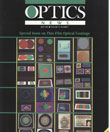
July, 1989 Issue
- Improving the performance of interference coatings for high-power laser optics
- Coatings for ophthalmic lenses
- Optical interference coatings for the inhibiting of counterfeiting
- The manufacture of military optics at the Frankford Arsenal during W.W. II
- ASTM drafts standards for measuring scattered light
- Thin Film Optical Coatings
- Browse all Issues
Feature Articles
Improving the performance of interference coatings for high-power laser optics
Most optical surfaces within high-power laser systems require multilayer interference coatings. These are usually high-reflector (HR) coatings to provide a maximum reflectance at the laser wavelength or anti-reflection (AR) coatings to provide a minimum reflectance. Occasionally, polarizers or other types of beamsplitters are required. As the systems become more complicated, multiple wavelength requirements become more common, perhaps necessitating high reflectance at alignment laser wavelengths or high transparency for optical viewing through the system.
by C.K. CarnigliaCoatings for ophthalmic lenses
The correction of vision defects basically requires that the patient be provided with an optical device with a specified optical power. The most common way at present involves unifocal or multifocal lenses, in either mineral glasses or organic polymers.
by A. Colonna de LegaOptical interference coatings for the inhibiting of counterfeiting
The counterfeiting of valuable papers and the forging of documents has always been a serious concern to all who issue such articles. In addition, labels of many highly prized brand-name consumer products are targets for counterfeiters. This threat has been increased by very significant improvements in color printing technology and by the development of color duplicating machines, both of which are capable of generating close reproductions of the original. Such new technology has made much of the traditional art of the counterfeiter obsolete.
by J.A. DobrowolskiThe manufacture of military optics at the Frankford Arsenal during W.W. II
I arrived at the Optical Production Department of the Frankford Arsenal in Philadelphia early in 1942 and was acquainted immediately with the pressing problems besieging the manufacture of military optics. The Frankford Arsenal at that time was the center for design and testing of all optical "fire control" instruments used by the U.S. Army. Included were binoculars, telescopes, range finders, battery commanders' scopes, aiming circles, and azimuth instruments, etc. The demands of World War II increased the personnel from a reported 11 in 1935 to 1,100 at the end of 1943, but the management of this shop was in the hands of several of the 11 people who were there in 1935, and, indeed, for many years before.
by Richard A. DentonASTM drafts standards for measuring scattered light
An ASTM subcommittee set up recently to work on standardization of optical scattering measurements has begun its work by looking at Bidirectional Reflectance Distribution Function (BRDF) measurements from opaque specular and diffuse surfaces.
by Robert E. ParksOptical coatings is a broad field and there are many topics that could have been included in this special issue of Optics News. What we have here represents a small selection. Three papers describe particular applications and the fourth gives a personal account of a particularly interesting period in the history of the subject.
by H. Angus Macleod

![Manual probe system with needles for test of semiconductor on silicon wafer. [A. Morozov / Getty]](https://opnmedia.blob.core.windows.net/$web/opn/media/images/articles/2025/1125/departments/202511-cover-web.jpg?ext=.jpg)
![Researcher Clara Saraceno in the lab. [Image by Carsten Behler Photography]](https://opnmedia.blob.core.windows.net/$web/opn/media/images/articles/2025/1025/departments/202510-cover-web.jpg?ext=.jpg)
